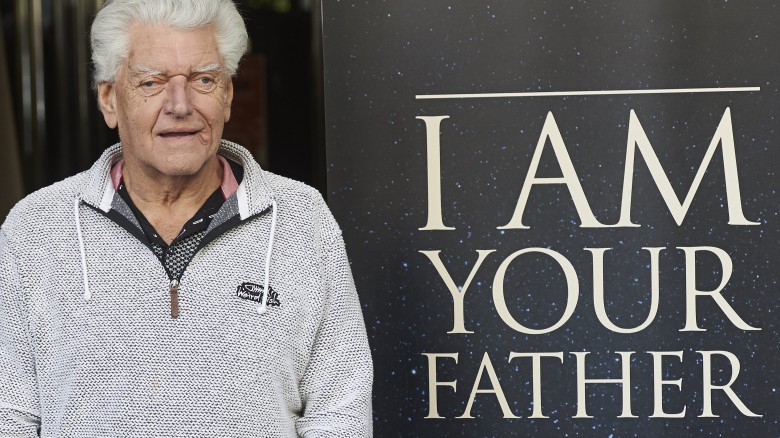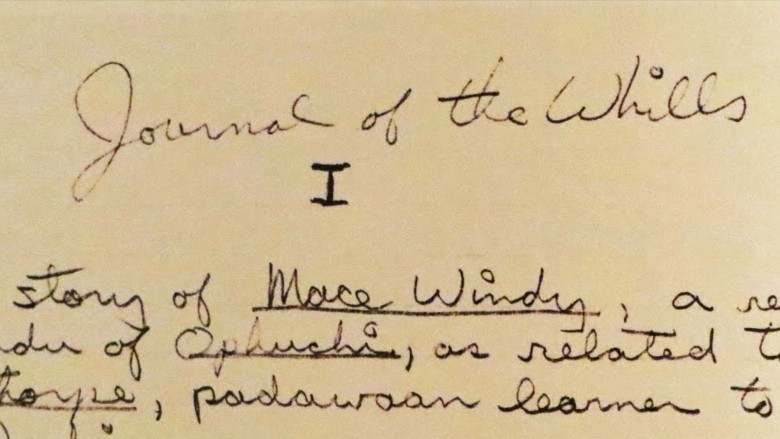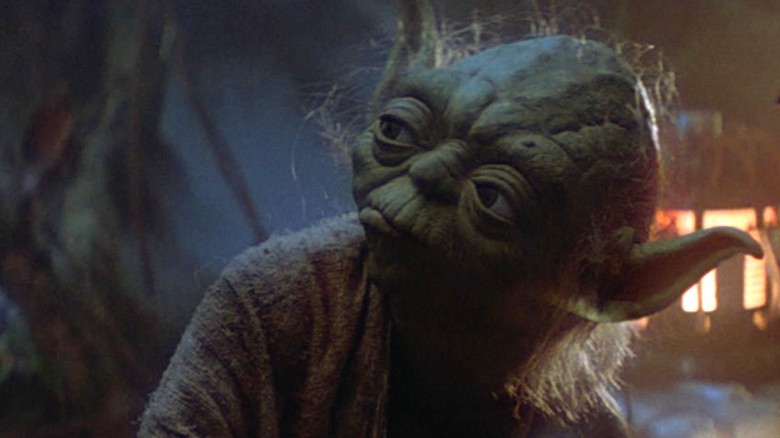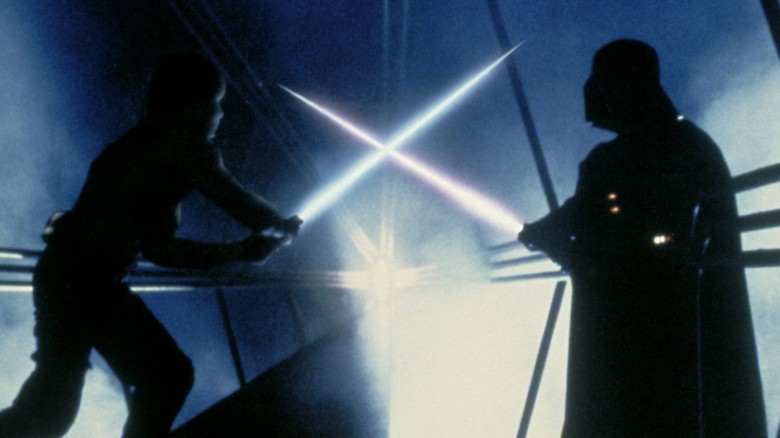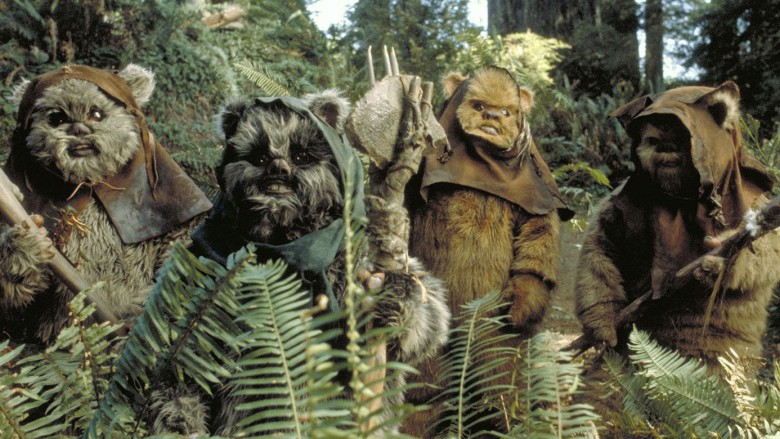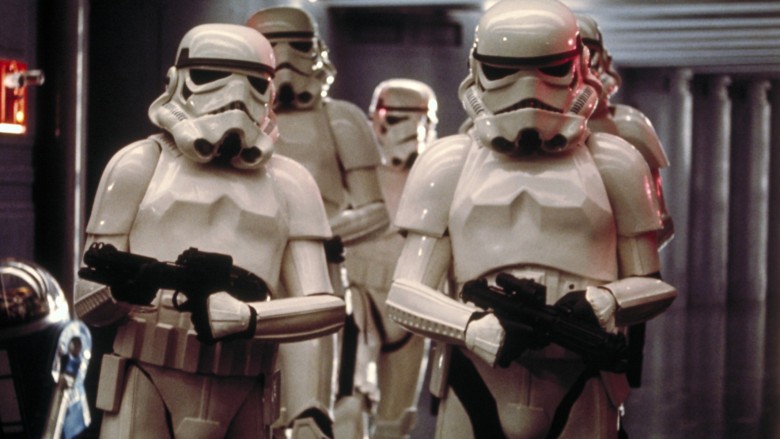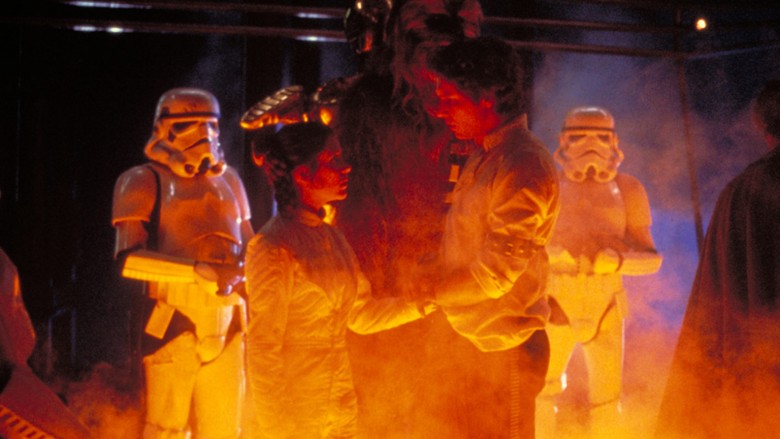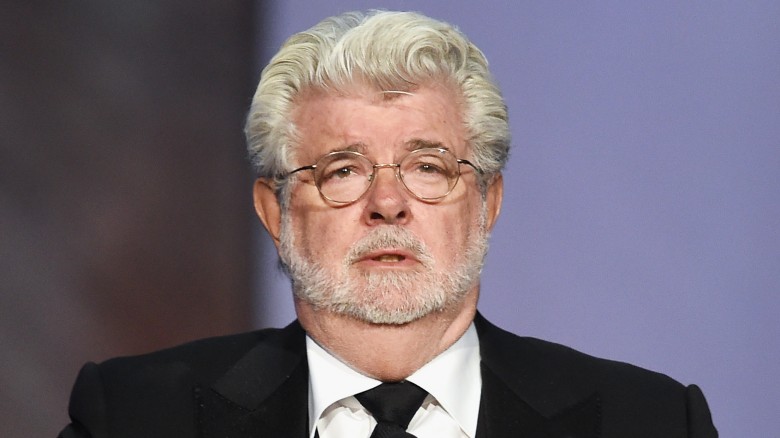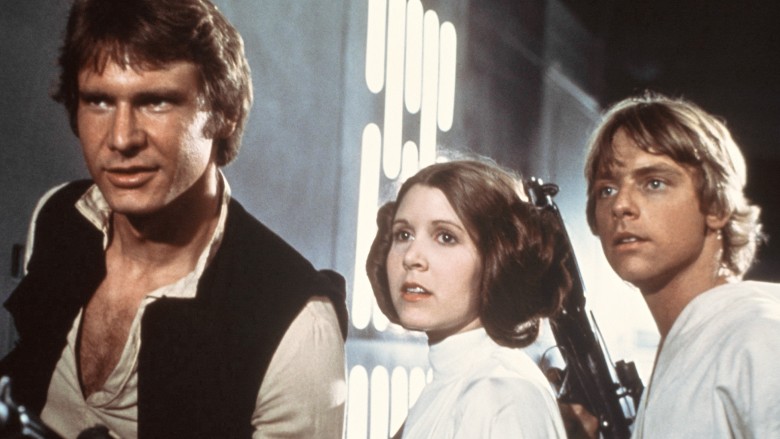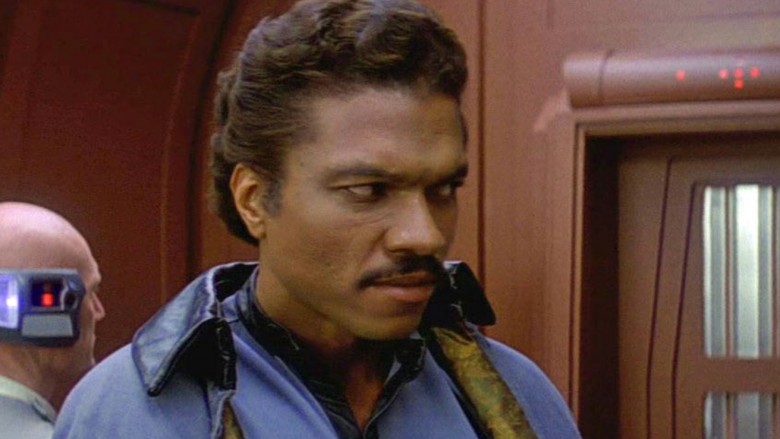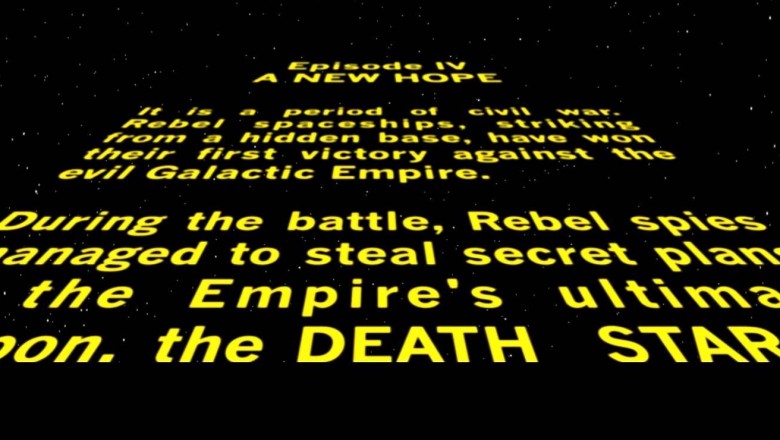Facts Star Wars Producers Hid From Fans
Since the saga started in 1977, Star Wars has been a force to be reckoned with. The phenomenal first movie spawned an entire universe of prequels, sequels, standalone films, and a variety of books, comics, and video games. For hardcore fans, then, there have been ample opportunities to soak in details from every corner of that galaxy far, far away—and many might believe they know all there is to know. However, there are still some rather tantalizing Star Wars secrets waiting for would-be padawan learners to discover.
The real Vader
When Darth Vader speaks, we hear James Earl Jones—but in the original Star Wars trilogy, the physical part was played by David Prowse, the bodybuilder who was actually inside the suit. For A New Hope, Prowse actually recorded every bit of Vader's dialogue, but fans can now only hear this very different Vader (nicknamed "Darth Farmer" by Carrie Fisher due to his accent) in outtakes and documentaries.
Given the length of time he played the character, it made sense for Prowse to be revealed when Luke Skywalker removed Vader's helmet in Return of the Jedi. Instead, Sebastian Shaw got the honors during Vader's brief moment of honest-to-goodness face time. For years, the easiest way for fans to see Prowse was to catch one of his appearances at sci-fi conventions, but even that's harder than it might sound: Prowse and George Lucas had a falling out, and he's reportedly been banned from official Star Wars fan conventions and events.
Who are the Whills?
For longtime fans, there's a lingering question that was teased as recently as Rogue One but has still never been answered: who the hell are the Whills? Lucas initially envisioned the Whills as observers of his galactic saga, even dubbing his original notes "The Journal of the Whills." Later drafts of his first Star Wars scripts would include a prophecy from this journal referencing "a savior" known as "the son of the sons," with Luke clearly standing in for the idea of a "chosen one" (an Lucas would return to in the prequel trilogy).
The Journal of the Whills pop up again in the novelization of the first Star Wars movie, which includes a two-page excerpted segment that briefly describes the fall of the Old Republic and rise of the Empire (and, to Lucas' credit, broadly outlines the prequels). In a deleted scene from Revenge of the Sith, Qui-Gonn credits his cool new blue Force ghost trick as something he learned from a "Shaman of the Whills." The Whills' Journal pops up again in a brief preface to the novelization of The Force Awakens, and finally, in Rogue One, Chirrut and Baz are presented as Guardians of the Whills, helping to guard one of their temples before it was stripmined by the Empire for Kyber crystals. Despite all of these tantalizing references, though, we still don't know who the Whills are. Force users? Certainly. Alive? Maybe. Purpose? No idea at all. Despite being part of Star Wars well before anyone saw the opening crawl, they remain as vague and mysterious as ever.
Who was the other hope for the galaxy?
This next one is something of a deep dive: who's the other hope for the galaxy that Yoda mentions? Fans sometimes conflate this with Yoda's deathbed confession of the identity of Leia, when he tries to say "there is another Skywalker," a message clarified by Obi-Wan Kenobi. However, in Empire Strikes Back, a concerned Kenobi watches Luke blasting away from Dagobah and proclaims "That boy is our last hope," and Yoda replies "No, there is another."
It may seem cut and dry that Yoda is referring to Leia, but it really isn't. Remember, Obi-Wan knows about the existence of Leia, yet he didn't bother to oversee her or train her, and seems to discount her when he says Luke is their "last hope." It seems unlikely that Yoda, who has far less of a relationship with Leia and her family than Kenobi, would suddenly think she was a hope for the galaxy. The original screenplay for Empire Strikes Back, based on a story treatment by Lucas, also mentioned an entirely different twin sister for Luke. Later, Empire producer Gary Kurts told TheForce.net that Leia wasn't meant to be Luke's sister and they planned for Luke to meet this new character in a later film. Where does that leave us? Yoda's "there is another" remains ambiguous. Was it the original twin sister we'll never meet? Was it someone we already know? As with many Star Wars mysteries, Lucas' lips are sealed.
What was Vader's original story?
This next deep dive jumps into the same well as the previous entry...because in the screenplay for Empire Strikes Back, written by Leigh Brackett following Lucas' original trilogy ideas and available online, you can see a pretty huge variation from the trilogy you know and love. Specifically, when Luke lands on Dagobah and meets Yoda (called Minch in this draft), he's introduced to the Force ghosts of Obi-Wan Kenobi and his father. That's right: Luke's father was definitely never intended to be Darth Vader, and that only happened when Lawrence Kasdan and George Lucas revised Brackett's script after she passed away.
This leaves a pretty big question. What was Vader's original story supposed to be? Presumably, he was still Obi-Wan's pupil, but this means Darth Vader really did betray and kill Luke's father in Lucas' original notes. What kind of relationship did they have? What would an Anakin who never turned to the Dark Side actually be like? These are tantalizing questions that Lucas, and now Disney, presumably have no interest in ever answering.
Star Wars has always been political
Star Wars generated political controversy in 2016 when the two writers of Rogue One, Gary Whitta and Chris Weitz, argued that the Empire represents a white supremacist movement that's notably opposed by a multicultural group that is led by a woman, and later changed their icons to Rebel insignia with safety pins, a sign of their commitment to issues of social justice and equality. The social media feedback was swift, with conservatives loudly voicing their opposition to Star Wars suddenly becoming political. Here's the secret, though: it always was.
According to a Lucas biographer, the first Star Wars was conceived in part as a sci-fi commentary on the Vietnam War, and make no mistake: America was the Empire, as Lucas was concerned with portraying "a large technological empire going after a small group of freedom fighters." If that sounds farfetched, Lucas doubled down on this idea in Return of the Jedi by deliberately modeling the Ewoks after the Viet Cong to show their triumph over their technologically superior foe, going out of his way to make them cute teddy bears kids could root for. Politics were still kicking around in the prequels, too, with many people noting that evil Anakin's "if you're not with me, you're my enemy" sounded a lot like George W. Bush. While Obi-Wan argued that "only a Sith deals in absolutes," both of them seemed to invite comparison to Bush's proclamation of "you're with us, or you're with the terrorists."
That Star Wars is actually a fantasy series
Many people think of Star Wars as science fiction. After all, you've got spaceships and laser blasters and aliens; seems pretty staightforward, right? However, as you may already know, George Lucas heavily based the story of Star Wars on the writings of Joseph Campbell, author of The Hero With a Thousand Faces. Campbell's big theory is that all heroic myths tell the same story, which fascinated Lucas. Therefore, by incorporating these elements, Lucas actually evokes many classical fantasy stories and tropes.
Don't believe it? Abstract Star Wars a bit, and it's the story of a young man with a destiny who receives a magic sword from a wise wizard. He then must storm a castle, face a black knight, and save a princess. This is a story that evokes fantasies like King Arthur much more than futuristic shows like Star Trek.
Speaking of Star Trek, the central premise of that show—and a lot of sci-fi in general—is that the future must be improved through dynamic change in everything from our technology to our way of life. Star Wars, though, focused on undoing change and restoring things back to the way they were, much like the Hobbits in Lord of the Rings fight to preserve the quiet life of the Shire instead of letting it become something new. Still not convinced? At the 2015 Sundance Film Festival, George Lucas blatantly said "Star Wars really isn't a science fiction film, it's a fantasy film and a space opera."
Han Solo almost died several times
When Han Solo died in The Force Awakens, many fans were shocked at this tragic turn of events. Some were even angry at Disney and the new Star Wars creative team for daring to kill such a beloved member of the original trilogy. Here's the secret, though: Han Solo nearly died decades ago, and Harrison Ford was the reason why.
Everyone remembers Han Solo being frozen in carbonite at the end of Empire Strikes Back and assumes that was always part of the plot. This wasn't the case, though—original drafts of the story included Han escaping with the others. What happened? Ford, unlike his younger co-stars, had refused to sign a multi-film contract, and was already making noise about not wanting to return. The carbonite freeze basically gave the writers the option to go either way with the sequel; if Ford backed out, Solo could be found dead, and if he renewed, he'd be revived. Later, Ford pushed for Han to die heroically in Return of the Jedi, but Lucas and the writers kept him alive. Thus, that "surprising" character death was actually Ford getting what he'd wanted for decades.
How George Lucas really got rich
Many people assume that George Lucas got rich through the Star Wars movies. The truth is, however, that Lucas made a lot more money through one simple arrangement he made before the movie ever premiered—an arrangement that had nothing at all to do with the films.
Because of his previous success with American Graffiti, Lucas was offered $500,000 by 20th Century Fox to direct Star Wars. The young director had only received $150,000 to direct Graffiti, so they were offering him what amounted to a huge raise. Lucas, however, made a counteroffer to the Fox executives: they could keep every penny of their extra money so long as Lucas retained the rights to all merchandise and any sequels. To the executives, this sounded like an absolute steal, as no Star Wars merchandise existed at the time and the studio barely understood what the movie was about, so no one was making premature sequel plans. Over the decades, the proceeds from this unorthodox deal helped make Lucas a billionaire—all because he turned down a few hundred thousand dollars.
Just how bad Star Wars almost was
It's tough to imagine the original Star Wars as anything other than an instant classic. It changed everything about the modern blockbuster, and its influences are still being felt. Many fans assume Lucas just got it right, and wonder what happened with the prequels. Here's the dirty secret, though: the original Star Wars was almost completely saved in editing—and by an entirely different Lucas.
Some of the raw footage from Star Wars can be viewed on the Empire of Dreams documentary, and it's rough, bearing little resemblance to the quality and polish of the eventual movie. Much of the editing was done by Marcia Lucas, George's wife at the time—and she wasn't just editing, she also altered the story throughout the entire filming process. She convinced George to keep human elements, such as Leia kissing Luke for luck, and also re-ordered shot after shot of the Death Star trench run until it reached a level of tense perfection. (Unfortunately for the prequels, the Lucases divorced in 1983.)
What the Clone Wars were originally about
For better or for worse, the Star Wars prequels delved into exactly what the Clone Wars were all about. These movies told a bizarre tale of clones fighting robots so that the galaxy's most gullible Senate would eventually turn its back on democracy. Needless to say, this wasn't the original plan, but Lucas has been relatively cagey about what the Clone Wars were originally supposed to be about—although we've been given some neat tidbits. For example, Lando Calrissian was originally conceived as a surviving clone from the Clone Wars who led a group of fellow veterans.
How'd that work? The character (then named Lando Kadar) was cloned by his grandfather, who wanted to create many different clone descendants. Interestingly, these clones were apparently somehow hunted and killed during the Clone Wars—a very different vision from the idea of triumphant proto-Stormtroopers. Other canonical and non-canonical stuff gives more interesting glimpses of the Clone Wars that could have been, including a canceled Kenner playset from the 1980s that would have focused on the Atha Prime, a genetics guru and architect of the Clone Wars. Also, in Timothy Zahn's once-canonical Thrawn Trilogy, there are allusions to crazed clones being created by rogue clonemasters and attacking the Republic. All of these are alternative stories that audiences could have gotten instead of Attack of the Clones.
The high price Lucas paid for being a rebel
Ever had that double-take moment when you watch a really old movie and you have to sit through a bunch of credits at the beginning? It seems weird and antiquated now, but it was once simply how things were done in Hollywood. George Lucas is the reason all of that changed, and he paid a relatively high price to do so.
Whatever critics may think of Lucas, he's always had a sense of presentation. He insisted on moving the credits for all of his Star Wars movies to the end rather than the beginning, thus letting moviegoers jump right from the "Long time ago" to the dramatic opening crawl. This angered the writers' and directors' guilds, and while they let it slide on the first Star Wars movie (assuming, like many, that it would be a flop), they fined Lucas $250,000 when he pulled the stunt again on Empire Strikes Back. This was actually a hefty sum (nearly half of what 20th Century Fox wanted to pay Lucas for directing the first movie, and that amount was considered generous), and Lucas burned bridges with these guilds along with the Motion Picture Association of America, which actually affected who he could hire for Return of the Jedi and other films. Ultimately, however, he had the last laugh, as his gutsy move became the default in Hollywood.

